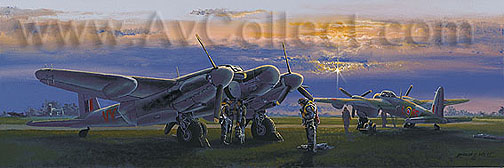
|
Time To Go Overall size 28 ” x 12½” Late 1944 and as the sun sets, Mark XIX Mosquito night fighters from 85 and 157 Squadrons based at RAF Swannington “crew up” for their next operation over hostile territory. These Mosquitoes scored many victories in the defence of Bomber Command aircraft and their crews during their relentless and dangerous missions over Germany. All are signed by the
artist and at least four former Signatories Flight Lieutenant Robert Bruce, DFC and Bar was accepted for aircrew training in February 1942, but only entered Navigation School at Mount Hope, Ontario in March 1943. From there he went to Greenwood, Nova Scotia and was again delayed so that it was already almost Christmas 1943 when he met Sq/Ldr Russ Bannock RCAF, DSO, DFC and Bar, and was accepted by him as navigator. They reached No 418 Squadron RCAF who were Intruders in No 11 Group at D-Day and they destroyed a ME 110 landing at Bourges/Avord on 13/14 June. The Squadron was heavily engaged with VI Flying Bombs through July and August and they destroyed 19. Their other work was on Night Rangers over France and Germany and occasionally on Day Rangers mostly in the Baltic, usually paired with another Mosquito VI. Robert Bruce and Sq/Ldr D A MacFadyin DSO, DFC went to 406 Squadron to train them in Intruder techniques until the war ended and after that he went as Navigation Officer to No 29 Squadron.
During training ‘Jock’ Cairns was crewed with an experienced pilot and posted to the prestigious 85 Squadron, Fighter Command and together with his pilot Sq/Ldr Simon Maude, DFC, achieved the destruction of a Dornier 217 during the Canterbury blitz. After six months rest from operations, John took over as the Navigator/Radio Leader of the Squadron – a short and lively tour intruding against Luftwaffe night-fighter airfields and interdiction of rail traffic during which five locomotives were destroyed. After another six months, Fl/Lt Cairns re-crewed with Fl/Lt John Hall (see next signatory) and they enjoyed a very successful tour with 488 Squadron, RNZAF in 2nd TAF and were both credited with eight victories and each awarded the DFC with Bar.
After a rest from operations, during which he taught budding night fighter pilots air gunnery, John Hall teamed up with John Cairns as his navigator/ radar operator and they joined 488 New Zealand Night Fighter Squadron at Bradwell Bay on the Essex coast, destroying three German bombers during the “mini-blitz” of early 1944. The Squadron flew over the D-day beaches from Zeals, and Colerne in Wiltshire, before moving at the end of 1944 to Amiens Glisy in northern France and then to Gilze Rijen in Holland, where it celebrated VE Day. During this time Hall shot down a further 5 German aircraft over France and Germany.
Geoff then volunteered to fly Mosquitoes in 8 Group and flew with 571 LNSF Squadron from mid-March 1945, completing a further thirteen operations, eight to Berlin, the last to Munich on the 25th April 1945.
He was posted to 3 Squadron (Hurricane) at Martlesham Heath in June 1941 and became Flight Commander in March 1942. On one sortie in August 1942 whilst attacking Dieppe, the port tank of his Hurricane was shot through but he was still able to return and land safely in England, for which he was subsequently awarded the DFC. He was posted to 534 Squadron (Turbinlite) as a Hurricane Flight Commander in September 1942 and then to 157 Squadron (Mosquito) at Castle Camps and became Flight Commander in July 1943.
Early in 1944 he joined 85 Night Fighter Squadron, 11 Group Fighter Command, at West Malling in Kent, where he flew Mosquitoes on defensive night fighter patrols. In May 1944, 85 Squadron was transferred to 100 Group Bomber Command at Swannington in Norfolk where the Squadron initiated Bomber Support. This meant changing from defensive night fighting to offensive night fighting, attacking Luftwaffe night fighters over Germany. Each aircraft was a predator on its own without the benefit of any Ground Control. They patrolled Luftwaffe airfields, radar beacons and accompanied bomber streams, generally creating havoc amongst the German night fighters. Jim York stayed with the Squadron until the end of the war and completed 39 Operations over the continent destroying two enemy aircraft. Shortly after moving to Swannington, the Squadron was switched back to West Malling for a short spell to help deal with the VI flying bomb menace and Jim went on to destroy four of the V1 bombs over the English Channel. After the war he resumed his career as a Chartered Surveyor.
|
|
![]()
All
major credit cards are accepted with delivery taking usually
5-7 days for Europe and 7-10 days for the rest of the World.
Back to Philip's
Aviation
Art
AvCollect Home Site Contents Art Gallery Buccaneer Photograph Gallery Whats New Contact Us